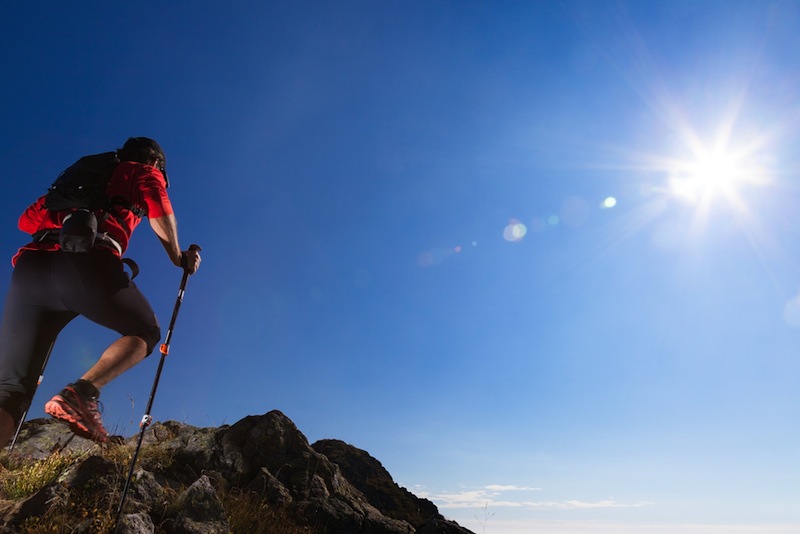Ultramarathon Runner Sets Appalachian Trail Record: How He Did It

An ultramarathon runner overcame an early injury, sleep deprivation and steep terrain to complete an astounding 2,189-mile (3,523 kilometers) run along the Appalachian Trail in 46 days and 8 hours, breaking the previous unofficial record by 3 hours.
Scott Jurek, who lives in Colorado when he's not sprinting to new records, persevered through knee pain and a muscle tear, as well as getting just 10 hours of sleep over the final four days of his trek, to claim the record. Successfully running an ultramarathon is a highly scientific process — not only do these athletes need to manage nutrition and energy, but they also need to be able to hold their bodies at the brink of exhaustion and yet remain in their right minds.
Jurek set off from Springer Mountain in northern Georgia on May 27 and wound up on the 5,270-foot-high (1,606 meters) peak of Mount Katahdin, in Maine, on July 12. The average hiker typically takes five to seven months to complete the hike. [Run Off-Road: 8 Picturesque Trail Runs]
"I think the biggest reason for me after all these years of running ultramarathons and testing my body was really to, you know, find a new level of adventure," Jurek told NPR in an interview. "It's really experiencing things and having to deal with adversity and, you know, events that you never anticipated."
Official ultramarathon races are held each year around the world, but those distances are usually 50 or 100 miles (80 or 161 km). Jurek's trek was considerably longer, and his record is considered unofficial because there is no governing body to verify completion times for these types of extreme events, said Javier Folgar of the Appalachian Trail Conservancy.
"Every year, we have about 2,500 to 3,000 people attempt to hike the trail," but only one out of every four people will stick out the entire journey, he said. "I think that one of the major reasons is that people don't know what to expect — how demanding it is to hike day in and day out, the changing weather and gear you have to carry."
Expect the unexpected
Get the world’s most fascinating discoveries delivered straight to your inbox.
Jurek, who is 41, nearly abandoned his record-breaking attempt in the mountains of Tennessee and North Carolina because of knee pain and a muscle tear, reported the Associated Press. But his perseverance paid off.
"He knows his body better than anybody else," said Jake Emmett, a professor of exercise studies at Eastern Illinois University in Charleston, Illinois. Emmett said he'd likely advise less-experienced runners to rest for a longer time before sprinting back into action, but Jurek is an experienced runner who is able to cope and handle his pain.
"Researchers do know that there are genetic differences in people that run distances like this … that allow a person to do things like that," Emmett said. Although Jurek still had to train and fight through pain and discomfort, he likely had a greater capacity for endurance events than the average person has, Emmet said.
"Running that long with a heart rate elevated for that long of a time will cause some minor breakdown of heart tissue and heart muscle," which can cause stress on your heart, Emmett said. But for ultramarathoners, who have trained their bodies to perform at extreme levels, "that small amount of damage or impairment to the heart really is insignificant as far as the function of the heart. The heart can still beat and pump blood like it's designed to do," he added.
The stress on the heart is temporary, lasting anywhere from a few hours to a day or two after the marathon, Emmett said. Ultramarathon runners can sustain the rigors of long-distance running without compromising their hearts, he said, as long as they train properly. [6 Amazing Desert Races]
But, there are still limits. No matter how much an athlete trains, the brain is designed to stop the body from hurting itself while running. According to the "central fatigue theory," the brain protects the heart by causing fatigue in the muscles, "and then that person, no matter how motivated they were, wouldn't be able to push their heart into that red zone, or the danger zone," Emmett said. Instead, muscle fatigue would cause the body to collapse.
Limited shut-eye
Jurek did not report collapsing, but he said he did take naps throughout his lengthy trek. The ultramarathoner told NPR he typically got 5 or 6 hours of sleep a night during the run. As the terrain intensified, he reportedly got around 4 or 5 hours of sleep, and then toward the end of the race, he sometimes slept only an hour.
Getting limited sleep is something that both the athletic and nonathletic can do — all people have the ability to get by on less sleep for a little while, Emmett said. And getting even just a few hours of sleep over a period of time can be enough for the body to recover enough to continue. However, experts warn that limited shut-eye will eventually catch up to you.
"You're more likely to get sick or injured if you're not getting proper sleep, because of the recovery component," said John Honerkamp, a coach at New York Road Runners, a New York City-based organization that provides classes, clinics and online programs for runners.
"Sleep is a huge part of training," Honerkamp told Live Science. Weight training and other strenuous workouts break down the body, but sleeping helps to naturally rebuild muscles, he said.
Because ultramarathons are longer than most running events, competitors typically need to rest more during the event. "What Scott did, as far as in the ultra-realm, is just way far right of the spectrum compared to a 50K [31-mile run], which is just a few more miles tacked to the back of the marathon."
After such an extraordinary exertion, Jurek said he now just wants to relax for a while. "The biggest thing I'm looking forward to is putting my feet up, being home and enjoying some downtime," Jurek told the Associated Press after he completed his record-breaking trek. [9 Healthy Habits You Can Do in 1 Minute (Or Less)]
Testing the body
From his darkest moments of doubt to his jubilant final stretch, Jurek relied on a regimented nutritional plan to hydrate and fuel his body.
Jurek is an experienced ultra-runner and has won several elite ultramarathon races. However, "What he was really doing is called 'fast tracking,' which is when you run, hike or do both as fast as you possibly can,” said Sunny Blende, a sports nutritionist and ultra-runner. "It's not so much a sport, as it is usually trying to break a record for a distance like that," she explained.
The number one problem athletes experience while ultra-running is nausea and nutritional problems, but after training, "your gut gets a little bit used to being jostled around," Blende said.
Nutrition during training varies by runner; some load up on carbohydrates for energy, and others do something that Blende calls "better butter burning," which trains the body to burn fat rather than simple sugars.
Most people can digest about 240 calories per hour during exercise that ramps up their heart rate, like sprinting, but those calories are typically all carbohydrates. If you burn 600 to 1,000 calories and only have 240 calories available, "you can start to see the problem," Blende said.
Instead of relying on carbohydrates, some athletes can burn fat calories that their bodies are already carrying, Blende said. "The problem is, you can't just decide in your mind, OK, today I'm going to burn my fat instead of burning more carbohydrates. You have to train for that," she said.
To burn fat, some athletes eliminate all grain carbohydrates from their diets for a period of six to 10 weeks. During those weeks, people also keep their heart rates at a lower level by doing less intense, slower exercises. This allows the body to adapt to the change and build up fat-burning enzymes, Blende said. "Almost all ultramarathon runners have done some fat-burning training," she added. [How Many Calories Am I Burning? (Infographic)]
During fat-burning training, runners should also eat more cold-weather fruits than warm-weather, Blende recommends, because warm weather fruits, such as pineapple and papaya, have more sugars and carbohydrates.
During the actual run, Jurek and many ultra-runners consume "sports food," which is usually pre-digested, meaning all the fiber is removed, but the carbohydrates remain. The sports food comes in blocks, gels and drinks. As people run, their heart rates climb, and so athletes need to consume carbohydrate calories again, Blende said. But for people who have undergone fat-burning training, their bodies will be burning a higher amount of calories from fat than before, because they have built up fat-burning enzymes, she said.
Getting in the right mindset
But how do ultramarathoners remain focused for such long periods of time while doing high-intensity exercise?
As long as the body is functioning, the mind is free to wander while running. "Typically if you're going out for a 2-hour or 3-hour run, you can't focus the whole time — sometimes it's good to daydream," Honerkamp said.
But ultra-runners tend to be fiercely competitive, which can help them power through grueling races, said Jeff Brown, a psychologist at Harvard Medical School and author of the upcoming book "The Runner’s Brain" (Rodale Books), which will be released in September.
"[A]n ultra-marathoner typically possesses an ironclad identity characterized by a strong belief of completing any task that will face them in competition," Brown told Live Science in an email.
The reticular activating system, the part of the brain that regulates how we drift in and out of sleep, picks up on cues within and around the athlete to fortify or weaken that identity, which develops over time, Brown said.
During long races, it's also important for athletes to manage their emotions.
“In intensely challenging athletic events, an athlete will taste a broad range of emotion — anything from boredom or doubt to hope and exhilaration,” Brown said. The limbic system, the part of the brain that controls basic emotions and drives, can also “play a role in post-competition blues that comes on like an unwanted depression following a big event.”
Experienced athletes have control over their limbic systems “because smart athletes have intentionally practiced a variety of experiences — both positive and negative,” Brown said.
Ultra-runners on the rise
Ultramarathons have skyrocketed in popularity in recent years. "It's probably become tenfold greater now than 20 years ago," Blende said. "There were hardly any 100-mile runs in the '80s and '90s, and now there are several hundred 100-mile runs."
And as more and more people run marathons, runners will likely continue to break records, Emmett said. There was a time when people doubted anyone would break a 4-minute mile, but runners did it, he added.
Part of the reason has to do with evolution, he added. The "theory of persistent hunting" explains that as humans evolved, the only way they could survive was to run down their food, and the quicker they could run, the sooner they could eat. Although humans can cover long distances, Emmett said, increasing speed is trickier, but he said he "thinks we're heading that way."
"Someone like Scott is — I want to say freak as a compliment — a freak of nature" in a way that inspires people to want to do what he does, Honerkamp said.
Elizabeth Goldbaum is on Twitter. Follow Live Science @livescience, Facebook & Google+. Original article on Live Science.



